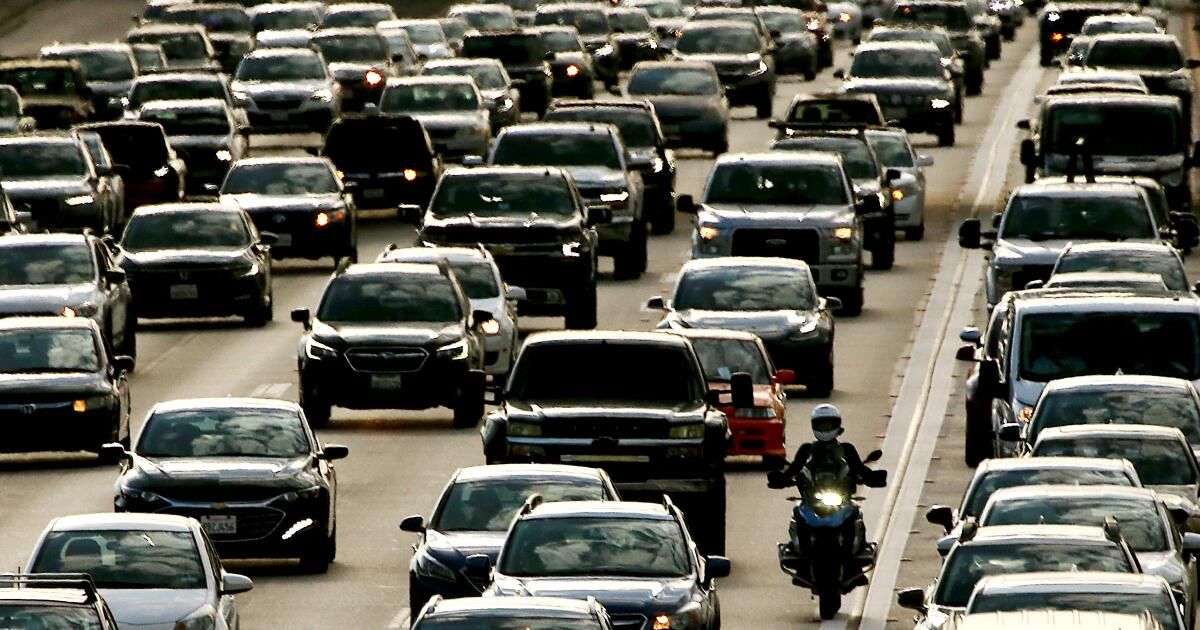California’s greenhouse gas emissions fell by about 2.4% in 2022, an encouraging sign that the state’s carbon footprint is declining once again even as the economy recovers from the COVID-19 pandemic, according to state officials.
The California Air Resources Board announced Friday that emissions of planet-warming gases were reduced by about 9.3 million metric tons of carbon dioxide in 2022 compared with 2021, the equivalent of taking 2.2 million gasoline-powered vehicles off the road for a year.
More than half of those reductions occurred in the transportation sector, as California drivers purchased more electric vehicles and less gasoline. In addition, freight trucks that transport goods from ports and rail yards are increasingly running on crop-derived biofuels, rather than conventional diesel fuel.
“The numbers are clear: our world-leading policies are reducing emissions, spurring innovation and moving us closer to meeting our climate goals,” Air Resources Board Chair Liane Randolph said in a statement. “A future with clean air and a vibrant economy is possible, and California is leading the way.”
The level of greenhouse gas emissions in 2022 was the lowest since 2020, a year marked by the pandemic, economic shutdowns and supply chain disruptions. In 2021, California emissions rose by about 3.4% due to increased consumerism and the resurgence of the economy following the development of a vaccine.
According to officials, the decline in greenhouse gas emissions in 2022 shows that the state is continuing to reduce carbon emissions while growing the economy. Between 2000 and 2022, statewide emissions have declined by 20%, while gross domestic product (the value of goods and services) has increased by 78%.
“One of the things I think is important to note is that there was a pretty dramatic decline during COVID in 2020 and a bit of a rebound [in 2021]“We didn’t see that uptick continue,” said Steven Cliff, executive director of the state Air Resources Board. “We didn’t see that uptick continue. Fortunately, the policies are working. And in fact, here in 2022 we’re very close to where we were in 2020 when you saw that really dramatic decline.”
California, the world’s fifth-largest economy and the nation’s largest population, has made substantial progress in transitioning away from fossil fuels. But questions remain about whether the state will meet its ambitious climate goals, including its 2030 target of reducing its carbon footprint by 40% compared with 1990 levels.
To meet that goal, Californians would have to remove an additional 113 million metric tons of carbon dioxide per year, an amount equivalent to the emissions from 29 coal-fired power plants.
Some experts have expressed skepticism about reaching that mark, but Cliff said he is optimistic.
“The goal here is to achieve the objectives required by law. [and] “Accelerating those efforts to achieve the long-term goals, obviously, as quickly as we can do it,” Cliff said.
“We have a lot of policies in place that are starting to become binding, and that’s why I expect the reductions to accelerate over time toward that goal,” Cliff added. “So I think we seem to be on the right track.”
Transportation remains the state’s largest source of emissions, with passenger vehicles contributing 27% of global warming gases. However, tremendous progress has been made in electric vehicle sales. In 2022, more than 300,000 plug-in hybrid or zero-emission vehicles were sold in California, accounting for nearly 20% of all light-duty vehicle sales.
The progress is encouraging as that share of auto sales increases in 2023, when 1 in 4 cars purchased in California will be zero-emission.
California continues to expand the role of renewable energy in its electric grid. About 50% of the state's energy comes from zero-emission wind, solar or nuclear power.
The state's industrial emissions also fell 2% to the lowest level since greenhouse gas estimates began in 2000, driven largely by continued declines in oil production.
Methane, a heat-trapping gas that warms the planet 80 times faster than carbon dioxide, has increased over the past two decades from dairy farms, landfills and leaks from the state’s oil pipelines. Officials say agricultural and waste emissions declined slightly in 2022 with the installation of cow manure storage facilities and reductions in solid waste, both aimed at reducing methane emissions.
But greenhouse gas emissions from commercial and residential buildings have risen as more workers return to large office buildings that require heating and cooling. As a result, emissions of hydrofluorocarbons (a gas that produces a high warming effect) have skyrocketed.
Fact Sheet
Towards a more sustainable California
Receive Boiling Point, our newsletter exploring climate change, energy and the environment, and be part of the conversation – and the solution.
You may occasionally receive promotional content from the Los Angeles Times.












